Training and Development's Effect on Organizational Performance
VerifiedAdded on 2020/04/21
|44
|9148
|48
Report
AI Summary
This report presents a case study investigating the impact of training and development on organizational performance, focusing on Safaricom's Call Centre. The study employed a case study approach, collecting data from 50 customer care executives through questionnaires and utilizing both descriptive and inferential statistics to analyze the data. The research examines the effects of training design, delivery style, and employee perception on organizational productivity. The findings indicate a significant positive correlation between training and development and organizational performance, emphasizing the need for continuous training to meet customer needs and maintain competitiveness in the telecommunications industry. The study concludes with recommendations for Safaricom to prioritize training and development as a key concern for both management and staff, ensuring improved employee skills and motivation, which in turn enhances overall organizational performance.
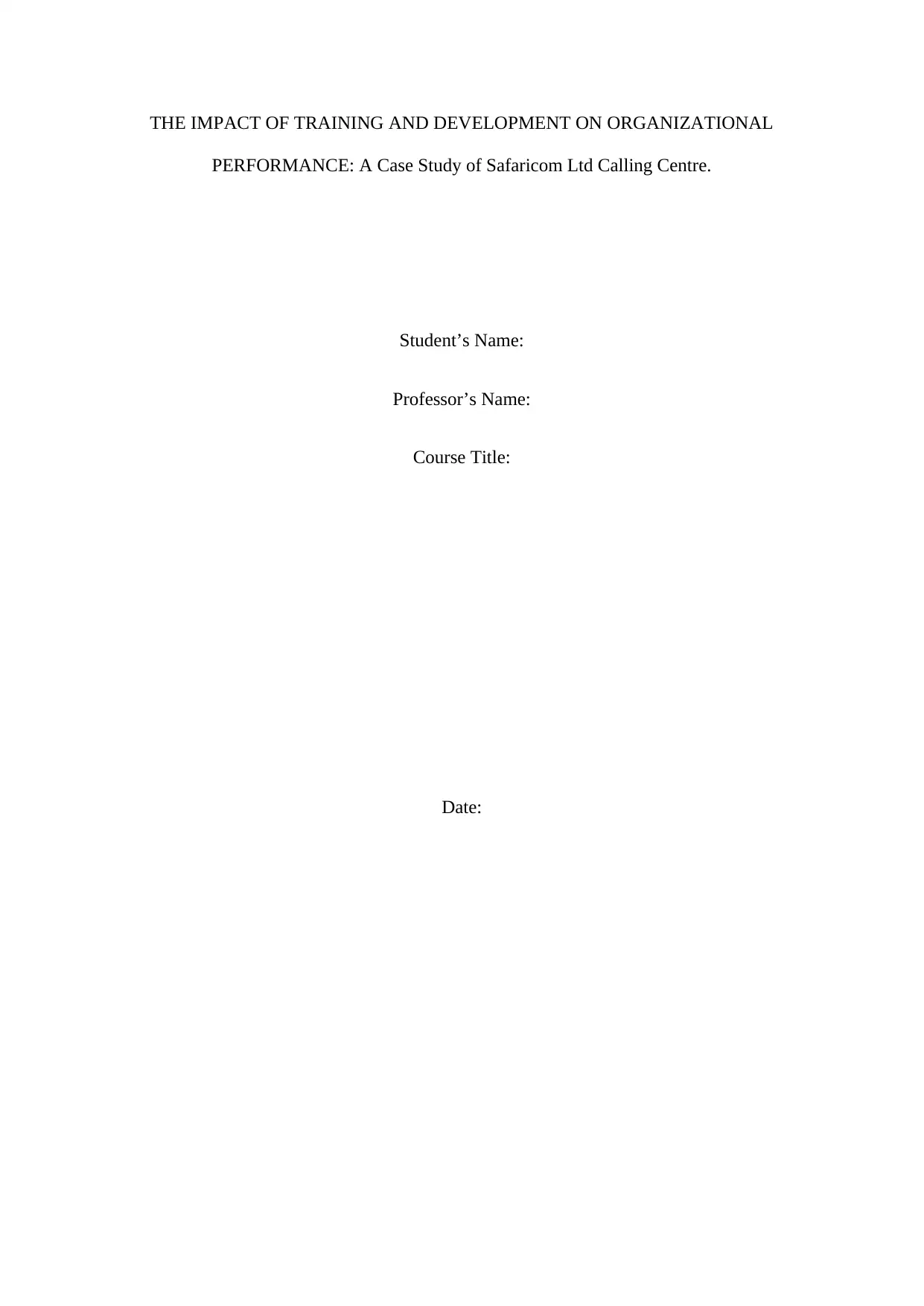
THE IMPACT OF TRAINING AND DEVELOPMENT ON ORGANIZATIONAL
PERFORMANCE: A Case Study of Safaricom Ltd Calling Centre.
Student’s Name:
Professor’s Name:
Course Title:
Date:
PERFORMANCE: A Case Study of Safaricom Ltd Calling Centre.
Student’s Name:
Professor’s Name:
Course Title:
Date:
Paraphrase This Document
Need a fresh take? Get an instant paraphrase of this document with our AI Paraphraser
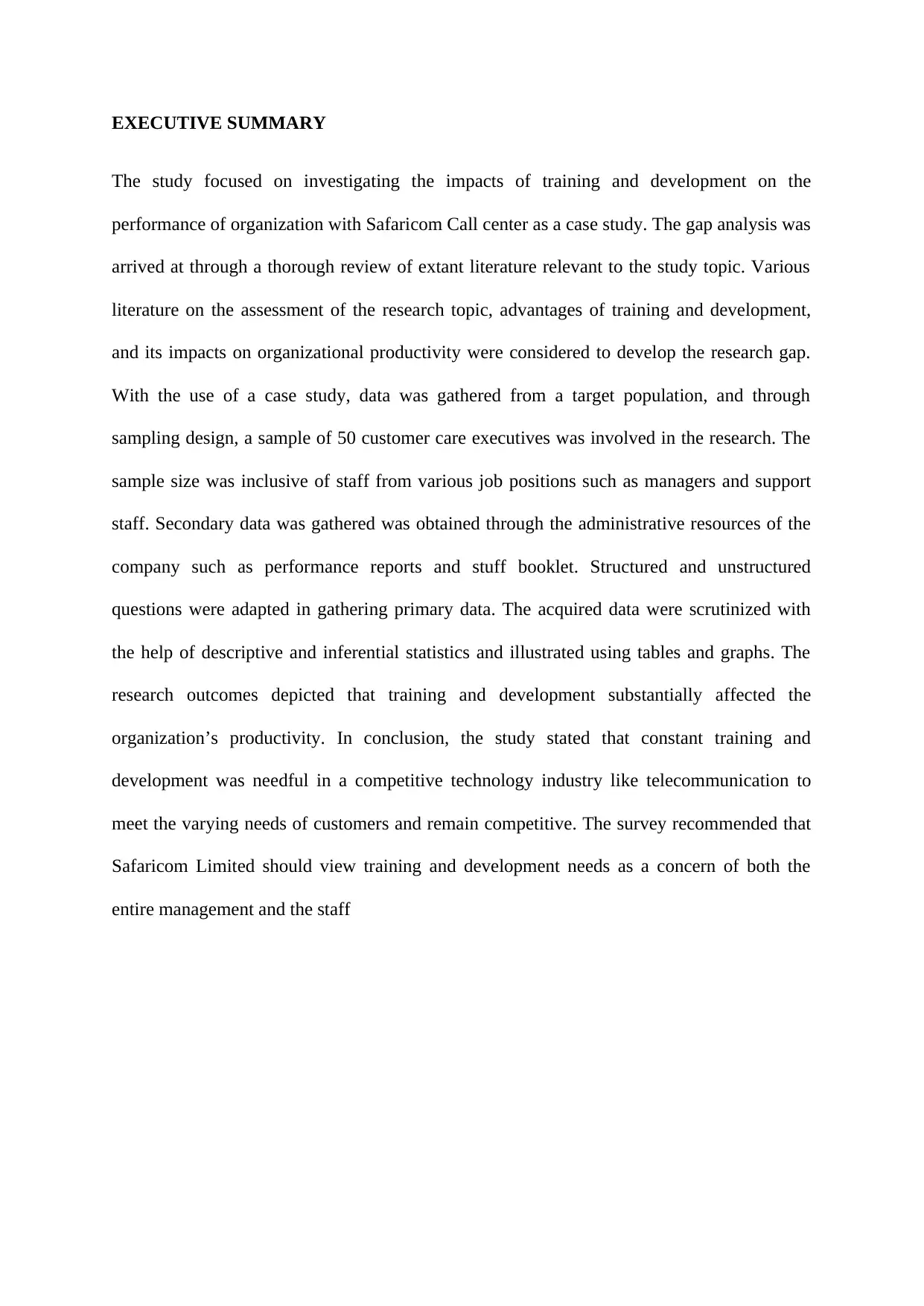
EXECUTIVE SUMMARY
The study focused on investigating the impacts of training and development on the
performance of organization with Safaricom Call center as a case study. The gap analysis was
arrived at through a thorough review of extant literature relevant to the study topic. Various
literature on the assessment of the research topic, advantages of training and development,
and its impacts on organizational productivity were considered to develop the research gap.
With the use of a case study, data was gathered from a target population, and through
sampling design, a sample of 50 customer care executives was involved in the research. The
sample size was inclusive of staff from various job positions such as managers and support
staff. Secondary data was gathered was obtained through the administrative resources of the
company such as performance reports and stuff booklet. Structured and unstructured
questions were adapted in gathering primary data. The acquired data were scrutinized with
the help of descriptive and inferential statistics and illustrated using tables and graphs. The
research outcomes depicted that training and development substantially affected the
organization’s productivity. In conclusion, the study stated that constant training and
development was needful in a competitive technology industry like telecommunication to
meet the varying needs of customers and remain competitive. The survey recommended that
Safaricom Limited should view training and development needs as a concern of both the
entire management and the staff
The study focused on investigating the impacts of training and development on the
performance of organization with Safaricom Call center as a case study. The gap analysis was
arrived at through a thorough review of extant literature relevant to the study topic. Various
literature on the assessment of the research topic, advantages of training and development,
and its impacts on organizational productivity were considered to develop the research gap.
With the use of a case study, data was gathered from a target population, and through
sampling design, a sample of 50 customer care executives was involved in the research. The
sample size was inclusive of staff from various job positions such as managers and support
staff. Secondary data was gathered was obtained through the administrative resources of the
company such as performance reports and stuff booklet. Structured and unstructured
questions were adapted in gathering primary data. The acquired data were scrutinized with
the help of descriptive and inferential statistics and illustrated using tables and graphs. The
research outcomes depicted that training and development substantially affected the
organization’s productivity. In conclusion, the study stated that constant training and
development was needful in a competitive technology industry like telecommunication to
meet the varying needs of customers and remain competitive. The survey recommended that
Safaricom Limited should view training and development needs as a concern of both the
entire management and the staff
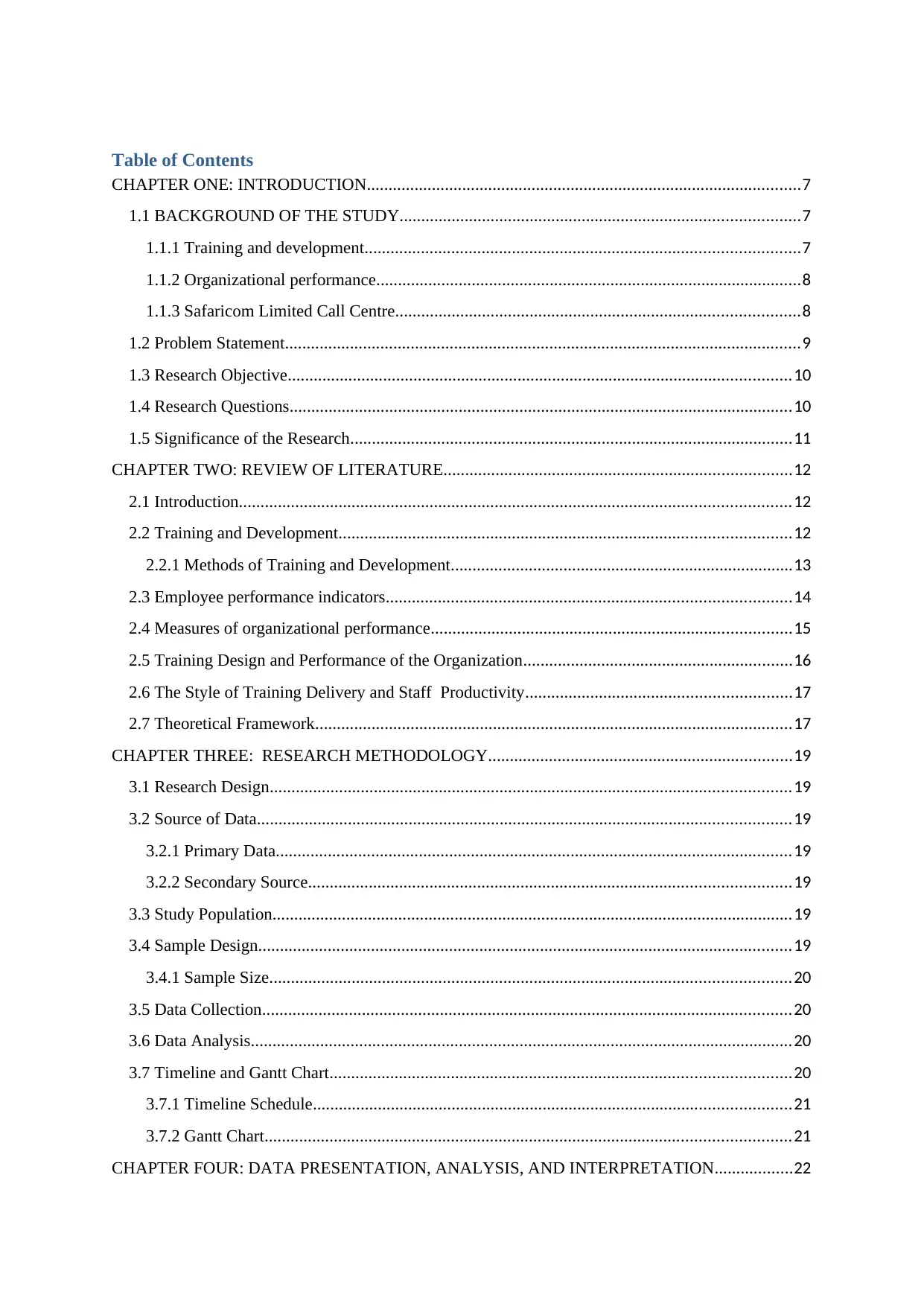
Table of Contents
CHAPTER ONE: INTRODUCTION....................................................................................................7
1.1 BACKGROUND OF THE STUDY............................................................................................7
1.1.1 Training and development....................................................................................................7
1.1.2 Organizational performance..................................................................................................8
1.1.3 Safaricom Limited Call Centre.............................................................................................8
1.2 Problem Statement.......................................................................................................................9
1.3 Research Objective....................................................................................................................10
1.4 Research Questions....................................................................................................................10
1.5 Significance of the Research......................................................................................................11
CHAPTER TWO: REVIEW OF LITERATURE................................................................................12
2.1 Introduction...............................................................................................................................12
2.2 Training and Development........................................................................................................12
2.2.1 Methods of Training and Development...............................................................................13
2.3 Employee performance indicators.............................................................................................14
2.4 Measures of organizational performance...................................................................................15
2.5 Training Design and Performance of the Organization..............................................................16
2.6 The Style of Training Delivery and Staff Productivity.............................................................17
2.7 Theoretical Framework..............................................................................................................17
CHAPTER THREE: RESEARCH METHODOLOGY......................................................................19
3.1 Research Design........................................................................................................................19
3.2 Source of Data...........................................................................................................................19
3.2.1 Primary Data.......................................................................................................................19
3.2.2 Secondary Source...............................................................................................................19
3.3 Study Population........................................................................................................................19
3.4 Sample Design...........................................................................................................................19
3.4.1 Sample Size........................................................................................................................20
3.5 Data Collection..........................................................................................................................20
3.6 Data Analysis.............................................................................................................................20
3.7 Timeline and Gantt Chart..........................................................................................................20
3.7.1 Timeline Schedule..............................................................................................................21
3.7.2 Gantt Chart.........................................................................................................................21
CHAPTER FOUR: DATA PRESENTATION, ANALYSIS, AND INTERPRETATION..................22
CHAPTER ONE: INTRODUCTION....................................................................................................7
1.1 BACKGROUND OF THE STUDY............................................................................................7
1.1.1 Training and development....................................................................................................7
1.1.2 Organizational performance..................................................................................................8
1.1.3 Safaricom Limited Call Centre.............................................................................................8
1.2 Problem Statement.......................................................................................................................9
1.3 Research Objective....................................................................................................................10
1.4 Research Questions....................................................................................................................10
1.5 Significance of the Research......................................................................................................11
CHAPTER TWO: REVIEW OF LITERATURE................................................................................12
2.1 Introduction...............................................................................................................................12
2.2 Training and Development........................................................................................................12
2.2.1 Methods of Training and Development...............................................................................13
2.3 Employee performance indicators.............................................................................................14
2.4 Measures of organizational performance...................................................................................15
2.5 Training Design and Performance of the Organization..............................................................16
2.6 The Style of Training Delivery and Staff Productivity.............................................................17
2.7 Theoretical Framework..............................................................................................................17
CHAPTER THREE: RESEARCH METHODOLOGY......................................................................19
3.1 Research Design........................................................................................................................19
3.2 Source of Data...........................................................................................................................19
3.2.1 Primary Data.......................................................................................................................19
3.2.2 Secondary Source...............................................................................................................19
3.3 Study Population........................................................................................................................19
3.4 Sample Design...........................................................................................................................19
3.4.1 Sample Size........................................................................................................................20
3.5 Data Collection..........................................................................................................................20
3.6 Data Analysis.............................................................................................................................20
3.7 Timeline and Gantt Chart..........................................................................................................20
3.7.1 Timeline Schedule..............................................................................................................21
3.7.2 Gantt Chart.........................................................................................................................21
CHAPTER FOUR: DATA PRESENTATION, ANALYSIS, AND INTERPRETATION..................22
⊘ This is a preview!⊘
Do you want full access?
Subscribe today to unlock all pages.

Trusted by 1+ million students worldwide
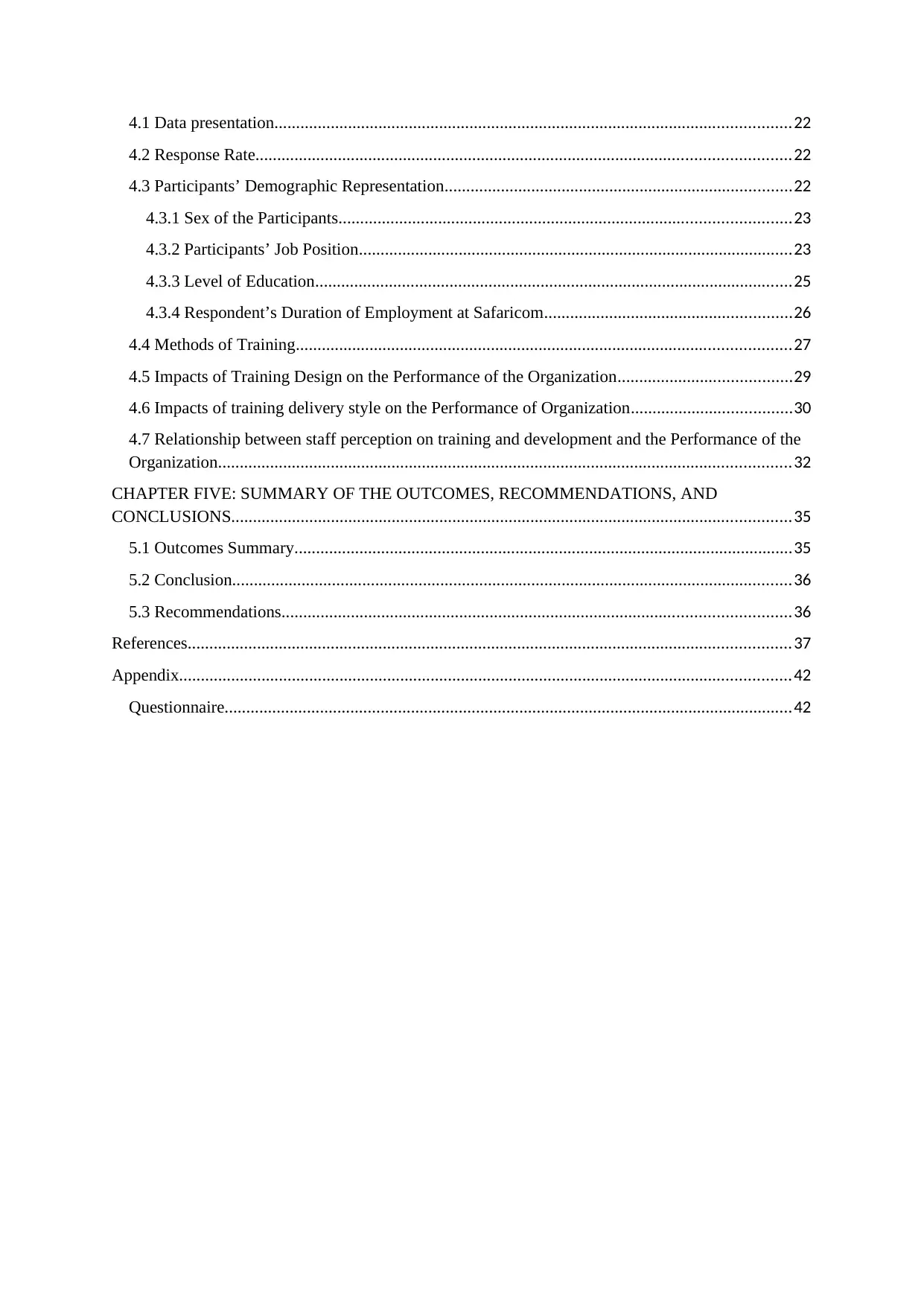
4.1 Data presentation.......................................................................................................................22
4.2 Response Rate...........................................................................................................................22
4.3 Participants’ Demographic Representation................................................................................22
4.3.1 Sex of the Participants........................................................................................................23
4.3.2 Participants’ Job Position....................................................................................................23
4.3.3 Level of Education..............................................................................................................25
4.3.4 Respondent’s Duration of Employment at Safaricom.........................................................26
4.4 Methods of Training..................................................................................................................27
4.5 Impacts of Training Design on the Performance of the Organization........................................29
4.6 Impacts of training delivery style on the Performance of Organization.....................................30
4.7 Relationship between staff perception on training and development and the Performance of the
Organization....................................................................................................................................32
CHAPTER FIVE: SUMMARY OF THE OUTCOMES, RECOMMENDATIONS, AND
CONCLUSIONS.................................................................................................................................35
5.1 Outcomes Summary...................................................................................................................35
5.2 Conclusion.................................................................................................................................36
5.3 Recommendations.....................................................................................................................36
References...........................................................................................................................................37
Appendix.............................................................................................................................................42
Questionnaire...................................................................................................................................42
4.2 Response Rate...........................................................................................................................22
4.3 Participants’ Demographic Representation................................................................................22
4.3.1 Sex of the Participants........................................................................................................23
4.3.2 Participants’ Job Position....................................................................................................23
4.3.3 Level of Education..............................................................................................................25
4.3.4 Respondent’s Duration of Employment at Safaricom.........................................................26
4.4 Methods of Training..................................................................................................................27
4.5 Impacts of Training Design on the Performance of the Organization........................................29
4.6 Impacts of training delivery style on the Performance of Organization.....................................30
4.7 Relationship between staff perception on training and development and the Performance of the
Organization....................................................................................................................................32
CHAPTER FIVE: SUMMARY OF THE OUTCOMES, RECOMMENDATIONS, AND
CONCLUSIONS.................................................................................................................................35
5.1 Outcomes Summary...................................................................................................................35
5.2 Conclusion.................................................................................................................................36
5.3 Recommendations.....................................................................................................................36
References...........................................................................................................................................37
Appendix.............................................................................................................................................42
Questionnaire...................................................................................................................................42
Paraphrase This Document
Need a fresh take? Get an instant paraphrase of this document with our AI Paraphraser
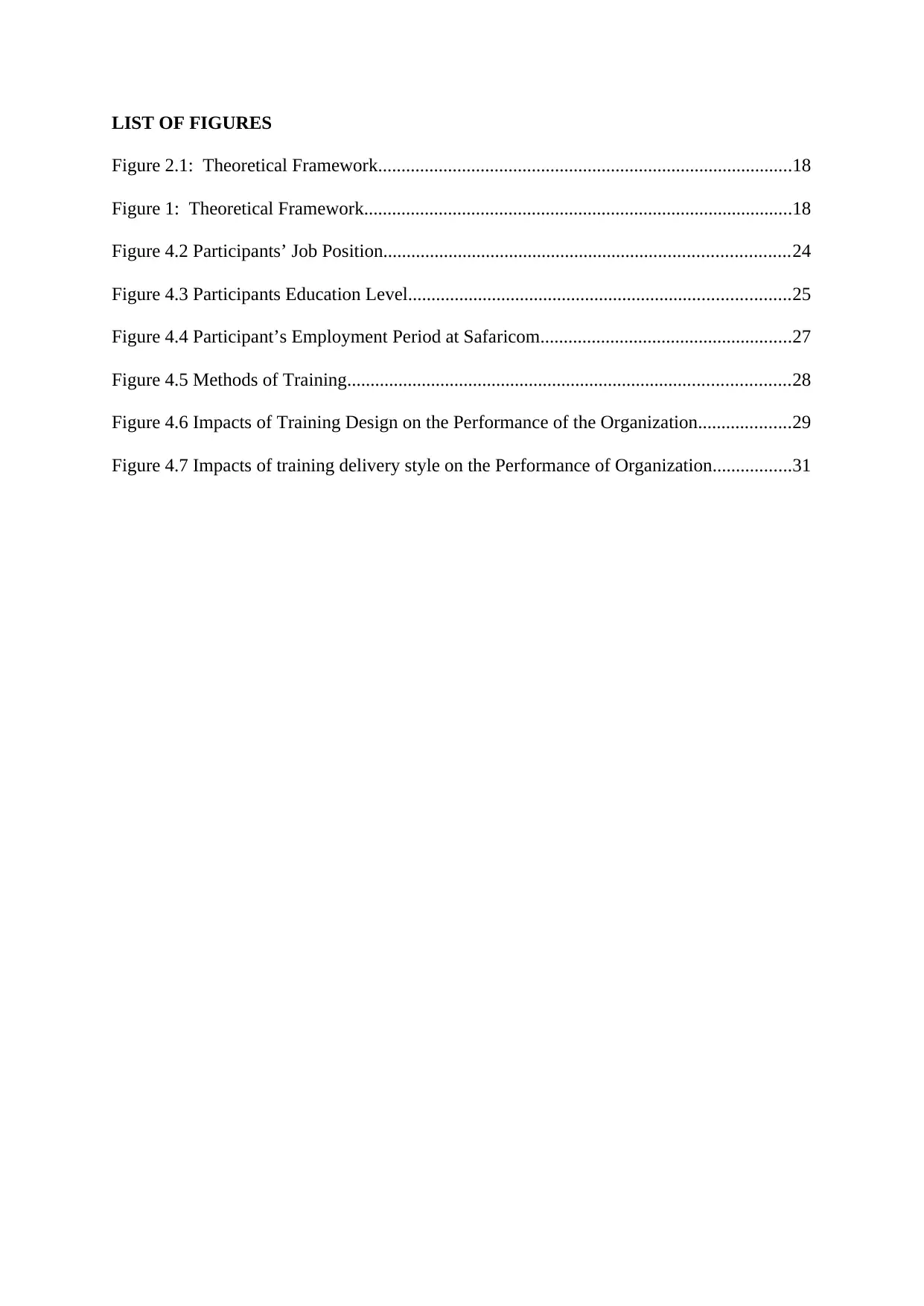
LIST OF FIGURES
Figure 2.1: Theoretical Framework.........................................................................................18
Figure 1: Theoretical Framework............................................................................................18
Figure 4.2 Participants’ Job Position.......................................................................................24
Figure 4.3 Participants Education Level..................................................................................25
Figure 4.4 Participant’s Employment Period at Safaricom......................................................27
Figure 4.5 Methods of Training...............................................................................................28
Figure 4.6 Impacts of Training Design on the Performance of the Organization....................29
Figure 4.7 Impacts of training delivery style on the Performance of Organization.................31
Figure 2.1: Theoretical Framework.........................................................................................18
Figure 1: Theoretical Framework............................................................................................18
Figure 4.2 Participants’ Job Position.......................................................................................24
Figure 4.3 Participants Education Level..................................................................................25
Figure 4.4 Participant’s Employment Period at Safaricom......................................................27
Figure 4.5 Methods of Training...............................................................................................28
Figure 4.6 Impacts of Training Design on the Performance of the Organization....................29
Figure 4.7 Impacts of training delivery style on the Performance of Organization.................31
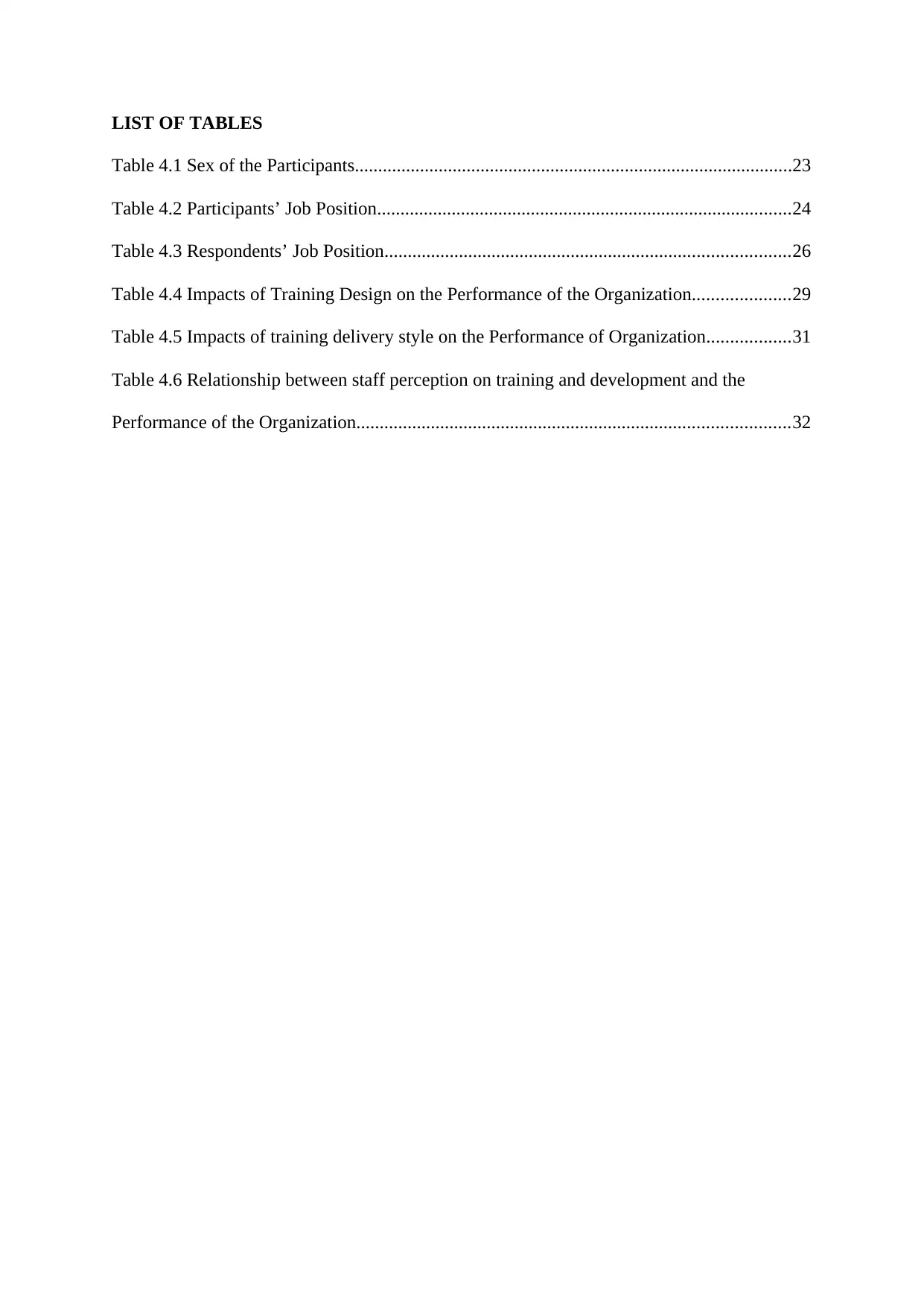
LIST OF TABLES
Table 4.1 Sex of the Participants..............................................................................................23
Table 4.2 Participants’ Job Position.........................................................................................24
Table 4.3 Respondents’ Job Position.......................................................................................26
Table 4.4 Impacts of Training Design on the Performance of the Organization.....................29
Table 4.5 Impacts of training delivery style on the Performance of Organization..................31
Table 4.6 Relationship between staff perception on training and development and the
Performance of the Organization.............................................................................................32
Table 4.1 Sex of the Participants..............................................................................................23
Table 4.2 Participants’ Job Position.........................................................................................24
Table 4.3 Respondents’ Job Position.......................................................................................26
Table 4.4 Impacts of Training Design on the Performance of the Organization.....................29
Table 4.5 Impacts of training delivery style on the Performance of Organization..................31
Table 4.6 Relationship between staff perception on training and development and the
Performance of the Organization.............................................................................................32
⊘ This is a preview!⊘
Do you want full access?
Subscribe today to unlock all pages.

Trusted by 1+ million students worldwide
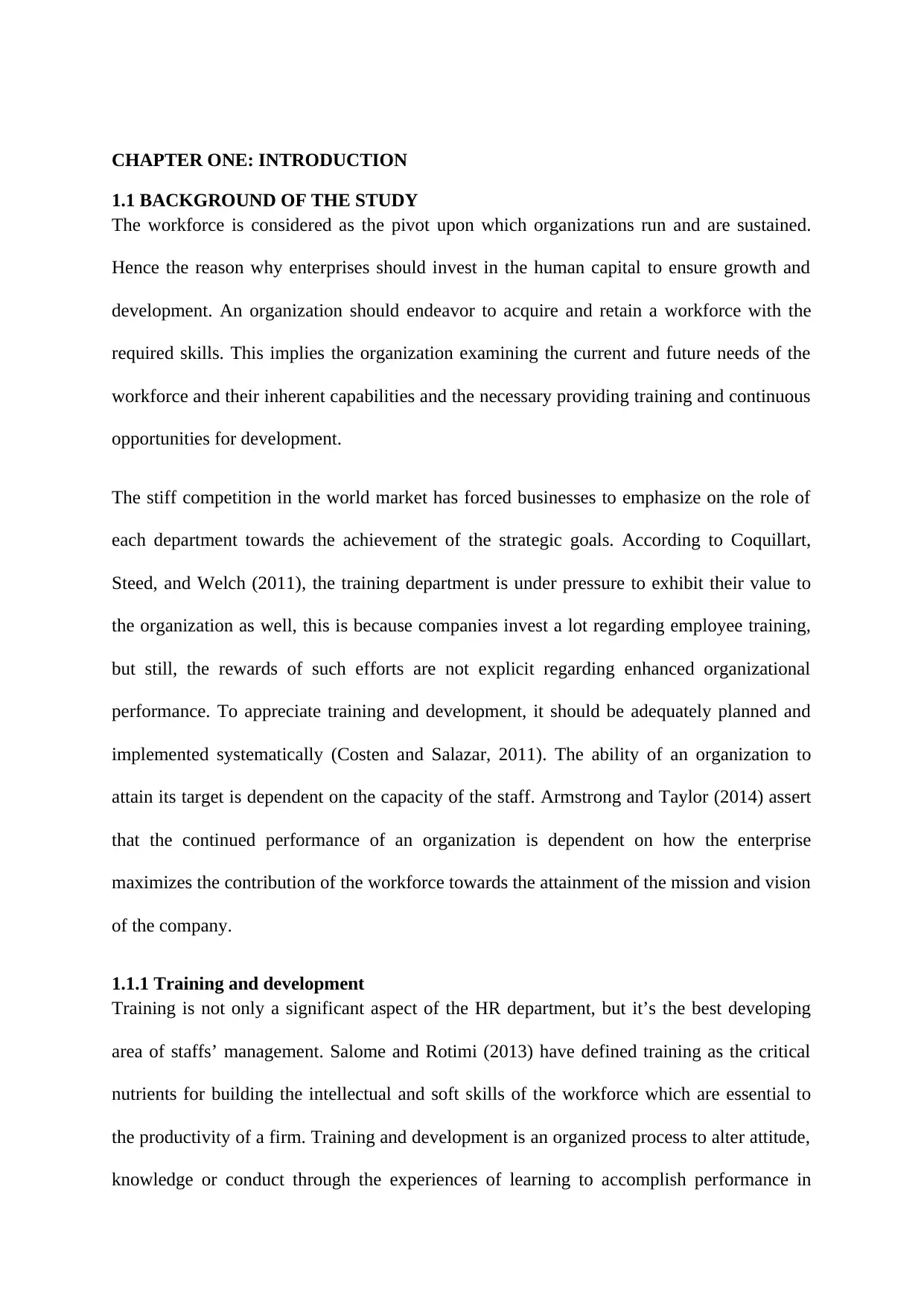
CHAPTER ONE: INTRODUCTION
1.1 BACKGROUND OF THE STUDY
The workforce is considered as the pivot upon which organizations run and are sustained.
Hence the reason why enterprises should invest in the human capital to ensure growth and
development. An organization should endeavor to acquire and retain a workforce with the
required skills. This implies the organization examining the current and future needs of the
workforce and their inherent capabilities and the necessary providing training and continuous
opportunities for development.
The stiff competition in the world market has forced businesses to emphasize on the role of
each department towards the achievement of the strategic goals. According to Coquillart,
Steed, and Welch (2011), the training department is under pressure to exhibit their value to
the organization as well, this is because companies invest a lot regarding employee training,
but still, the rewards of such efforts are not explicit regarding enhanced organizational
performance. To appreciate training and development, it should be adequately planned and
implemented systematically (Costen and Salazar, 2011). The ability of an organization to
attain its target is dependent on the capacity of the staff. Armstrong and Taylor (2014) assert
that the continued performance of an organization is dependent on how the enterprise
maximizes the contribution of the workforce towards the attainment of the mission and vision
of the company.
1.1.1 Training and development
Training is not only a significant aspect of the HR department, but it’s the best developing
area of staffs’ management. Salome and Rotimi (2013) have defined training as the critical
nutrients for building the intellectual and soft skills of the workforce which are essential to
the productivity of a firm. Training and development is an organized process to alter attitude,
knowledge or conduct through the experiences of learning to accomplish performance in
1.1 BACKGROUND OF THE STUDY
The workforce is considered as the pivot upon which organizations run and are sustained.
Hence the reason why enterprises should invest in the human capital to ensure growth and
development. An organization should endeavor to acquire and retain a workforce with the
required skills. This implies the organization examining the current and future needs of the
workforce and their inherent capabilities and the necessary providing training and continuous
opportunities for development.
The stiff competition in the world market has forced businesses to emphasize on the role of
each department towards the achievement of the strategic goals. According to Coquillart,
Steed, and Welch (2011), the training department is under pressure to exhibit their value to
the organization as well, this is because companies invest a lot regarding employee training,
but still, the rewards of such efforts are not explicit regarding enhanced organizational
performance. To appreciate training and development, it should be adequately planned and
implemented systematically (Costen and Salazar, 2011). The ability of an organization to
attain its target is dependent on the capacity of the staff. Armstrong and Taylor (2014) assert
that the continued performance of an organization is dependent on how the enterprise
maximizes the contribution of the workforce towards the attainment of the mission and vision
of the company.
1.1.1 Training and development
Training is not only a significant aspect of the HR department, but it’s the best developing
area of staffs’ management. Salome and Rotimi (2013) have defined training as the critical
nutrients for building the intellectual and soft skills of the workforce which are essential to
the productivity of a firm. Training and development is an organized process to alter attitude,
knowledge or conduct through the experiences of learning to accomplish performance in
Paraphrase This Document
Need a fresh take? Get an instant paraphrase of this document with our AI Paraphraser
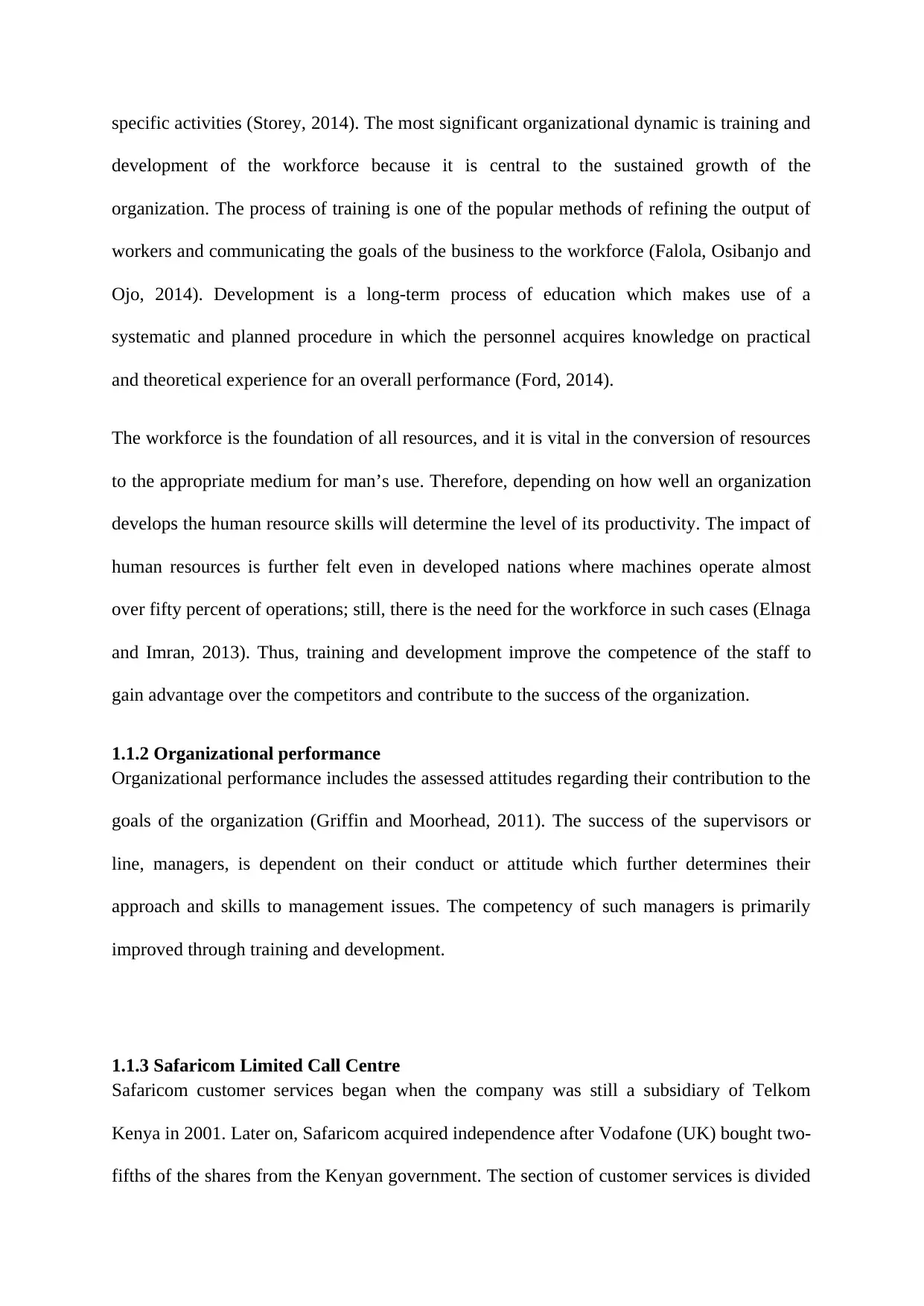
specific activities (Storey, 2014). The most significant organizational dynamic is training and
development of the workforce because it is central to the sustained growth of the
organization. The process of training is one of the popular methods of refining the output of
workers and communicating the goals of the business to the workforce (Falola, Osibanjo and
Ojo, 2014). Development is a long-term process of education which makes use of a
systematic and planned procedure in which the personnel acquires knowledge on practical
and theoretical experience for an overall performance (Ford, 2014).
The workforce is the foundation of all resources, and it is vital in the conversion of resources
to the appropriate medium for man’s use. Therefore, depending on how well an organization
develops the human resource skills will determine the level of its productivity. The impact of
human resources is further felt even in developed nations where machines operate almost
over fifty percent of operations; still, there is the need for the workforce in such cases (Elnaga
and Imran, 2013). Thus, training and development improve the competence of the staff to
gain advantage over the competitors and contribute to the success of the organization.
1.1.2 Organizational performance
Organizational performance includes the assessed attitudes regarding their contribution to the
goals of the organization (Griffin and Moorhead, 2011). The success of the supervisors or
line, managers, is dependent on their conduct or attitude which further determines their
approach and skills to management issues. The competency of such managers is primarily
improved through training and development.
1.1.3 Safaricom Limited Call Centre
Safaricom customer services began when the company was still a subsidiary of Telkom
Kenya in 2001. Later on, Safaricom acquired independence after Vodafone (UK) bought two-
fifths of the shares from the Kenyan government. The section of customer services is divided
development of the workforce because it is central to the sustained growth of the
organization. The process of training is one of the popular methods of refining the output of
workers and communicating the goals of the business to the workforce (Falola, Osibanjo and
Ojo, 2014). Development is a long-term process of education which makes use of a
systematic and planned procedure in which the personnel acquires knowledge on practical
and theoretical experience for an overall performance (Ford, 2014).
The workforce is the foundation of all resources, and it is vital in the conversion of resources
to the appropriate medium for man’s use. Therefore, depending on how well an organization
develops the human resource skills will determine the level of its productivity. The impact of
human resources is further felt even in developed nations where machines operate almost
over fifty percent of operations; still, there is the need for the workforce in such cases (Elnaga
and Imran, 2013). Thus, training and development improve the competence of the staff to
gain advantage over the competitors and contribute to the success of the organization.
1.1.2 Organizational performance
Organizational performance includes the assessed attitudes regarding their contribution to the
goals of the organization (Griffin and Moorhead, 2011). The success of the supervisors or
line, managers, is dependent on their conduct or attitude which further determines their
approach and skills to management issues. The competency of such managers is primarily
improved through training and development.
1.1.3 Safaricom Limited Call Centre
Safaricom customer services began when the company was still a subsidiary of Telkom
Kenya in 2001. Later on, Safaricom acquired independence after Vodafone (UK) bought two-
fifths of the shares from the Kenyan government. The section of customer services is divided
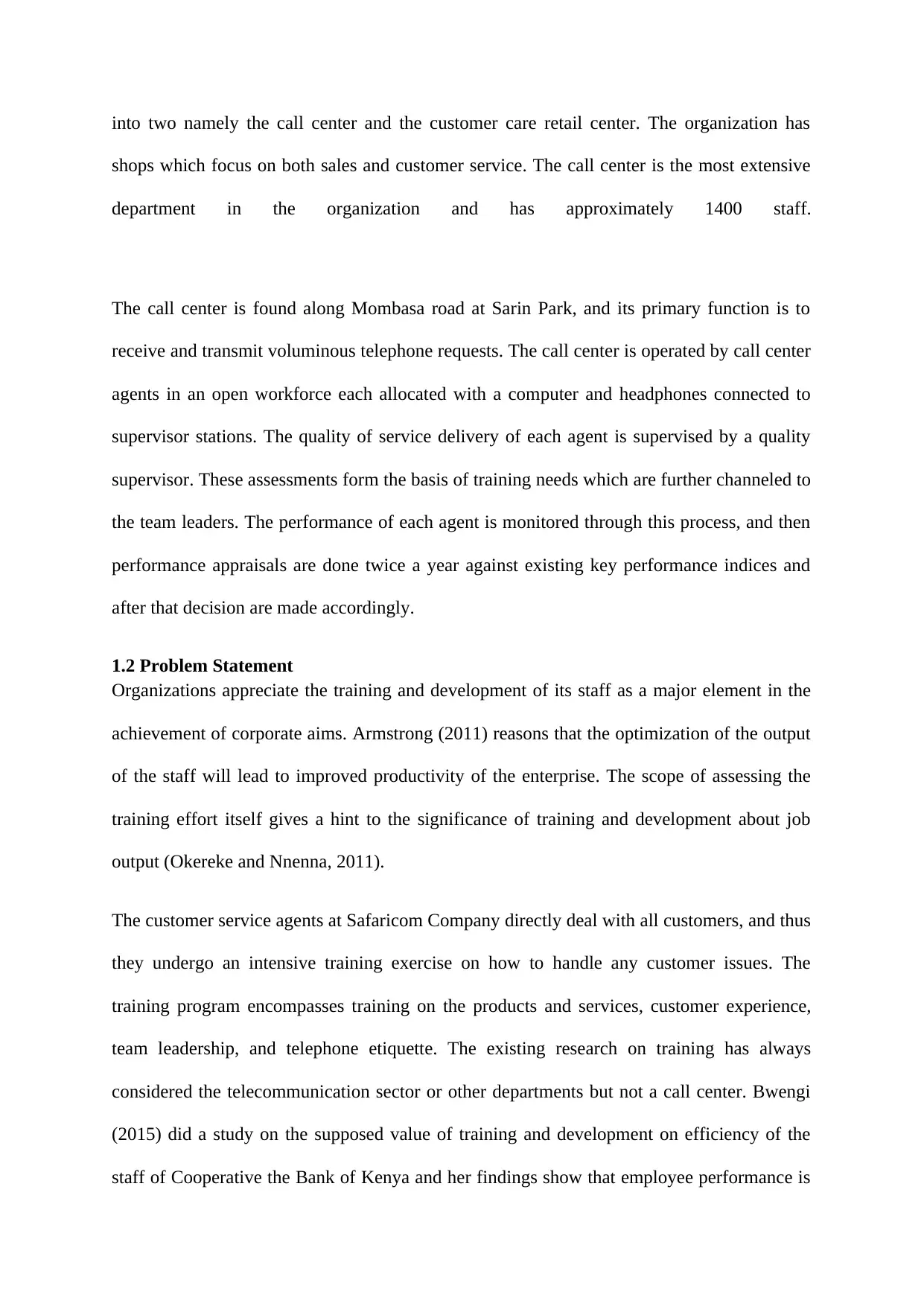
into two namely the call center and the customer care retail center. The organization has
shops which focus on both sales and customer service. The call center is the most extensive
department in the organization and has approximately 1400 staff.
The call center is found along Mombasa road at Sarin Park, and its primary function is to
receive and transmit voluminous telephone requests. The call center is operated by call center
agents in an open workforce each allocated with a computer and headphones connected to
supervisor stations. The quality of service delivery of each agent is supervised by a quality
supervisor. These assessments form the basis of training needs which are further channeled to
the team leaders. The performance of each agent is monitored through this process, and then
performance appraisals are done twice a year against existing key performance indices and
after that decision are made accordingly.
1.2 Problem Statement
Organizations appreciate the training and development of its staff as a major element in the
achievement of corporate aims. Armstrong (2011) reasons that the optimization of the output
of the staff will lead to improved productivity of the enterprise. The scope of assessing the
training effort itself gives a hint to the significance of training and development about job
output (Okereke and Nnenna, 2011).
The customer service agents at Safaricom Company directly deal with all customers, and thus
they undergo an intensive training exercise on how to handle any customer issues. The
training program encompasses training on the products and services, customer experience,
team leadership, and telephone etiquette. The existing research on training has always
considered the telecommunication sector or other departments but not a call center. Bwengi
(2015) did a study on the supposed value of training and development on efficiency of the
staff of Cooperative the Bank of Kenya and her findings show that employee performance is
shops which focus on both sales and customer service. The call center is the most extensive
department in the organization and has approximately 1400 staff.
The call center is found along Mombasa road at Sarin Park, and its primary function is to
receive and transmit voluminous telephone requests. The call center is operated by call center
agents in an open workforce each allocated with a computer and headphones connected to
supervisor stations. The quality of service delivery of each agent is supervised by a quality
supervisor. These assessments form the basis of training needs which are further channeled to
the team leaders. The performance of each agent is monitored through this process, and then
performance appraisals are done twice a year against existing key performance indices and
after that decision are made accordingly.
1.2 Problem Statement
Organizations appreciate the training and development of its staff as a major element in the
achievement of corporate aims. Armstrong (2011) reasons that the optimization of the output
of the staff will lead to improved productivity of the enterprise. The scope of assessing the
training effort itself gives a hint to the significance of training and development about job
output (Okereke and Nnenna, 2011).
The customer service agents at Safaricom Company directly deal with all customers, and thus
they undergo an intensive training exercise on how to handle any customer issues. The
training program encompasses training on the products and services, customer experience,
team leadership, and telephone etiquette. The existing research on training has always
considered the telecommunication sector or other departments but not a call center. Bwengi
(2015) did a study on the supposed value of training and development on efficiency of the
staff of Cooperative the Bank of Kenya and her findings show that employee performance is
⊘ This is a preview!⊘
Do you want full access?
Subscribe today to unlock all pages.

Trusted by 1+ million students worldwide
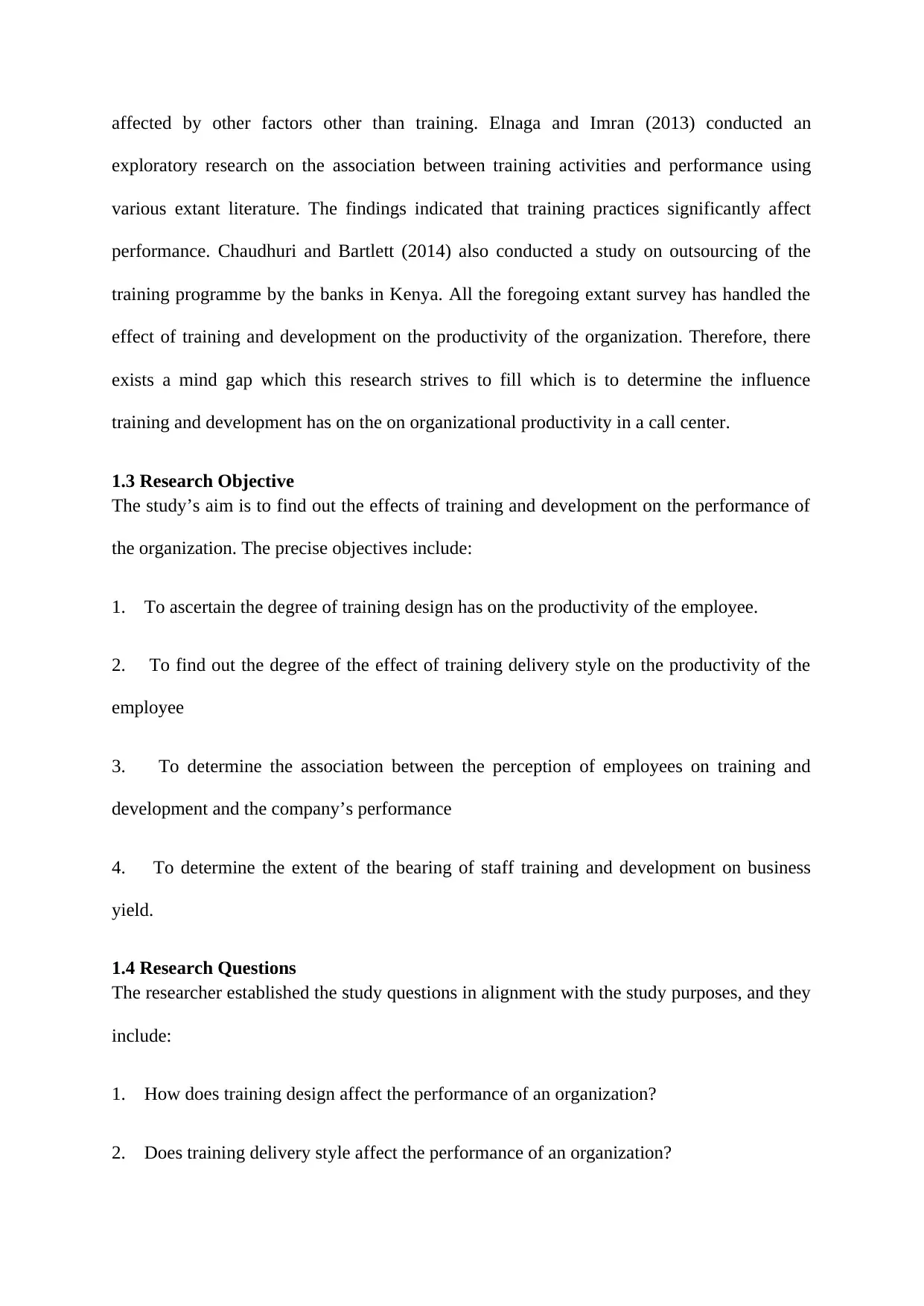
affected by other factors other than training. Elnaga and Imran (2013) conducted an
exploratory research on the association between training activities and performance using
various extant literature. The findings indicated that training practices significantly affect
performance. Chaudhuri and Bartlett (2014) also conducted a study on outsourcing of the
training programme by the banks in Kenya. All the foregoing extant survey has handled the
effect of training and development on the productivity of the organization. Therefore, there
exists a mind gap which this research strives to fill which is to determine the influence
training and development has on the on organizational productivity in a call center.
1.3 Research Objective
The study’s aim is to find out the effects of training and development on the performance of
the organization. The precise objectives include:
1. To ascertain the degree of training design has on the productivity of the employee.
2. To find out the degree of the effect of training delivery style on the productivity of the
employee
3. To determine the association between the perception of employees on training and
development and the company’s performance
4. To determine the extent of the bearing of staff training and development on business
yield.
1.4 Research Questions
The researcher established the study questions in alignment with the study purposes, and they
include:
1. How does training design affect the performance of an organization?
2. Does training delivery style affect the performance of an organization?
exploratory research on the association between training activities and performance using
various extant literature. The findings indicated that training practices significantly affect
performance. Chaudhuri and Bartlett (2014) also conducted a study on outsourcing of the
training programme by the banks in Kenya. All the foregoing extant survey has handled the
effect of training and development on the productivity of the organization. Therefore, there
exists a mind gap which this research strives to fill which is to determine the influence
training and development has on the on organizational productivity in a call center.
1.3 Research Objective
The study’s aim is to find out the effects of training and development on the performance of
the organization. The precise objectives include:
1. To ascertain the degree of training design has on the productivity of the employee.
2. To find out the degree of the effect of training delivery style on the productivity of the
employee
3. To determine the association between the perception of employees on training and
development and the company’s performance
4. To determine the extent of the bearing of staff training and development on business
yield.
1.4 Research Questions
The researcher established the study questions in alignment with the study purposes, and they
include:
1. How does training design affect the performance of an organization?
2. Does training delivery style affect the performance of an organization?
Paraphrase This Document
Need a fresh take? Get an instant paraphrase of this document with our AI Paraphraser
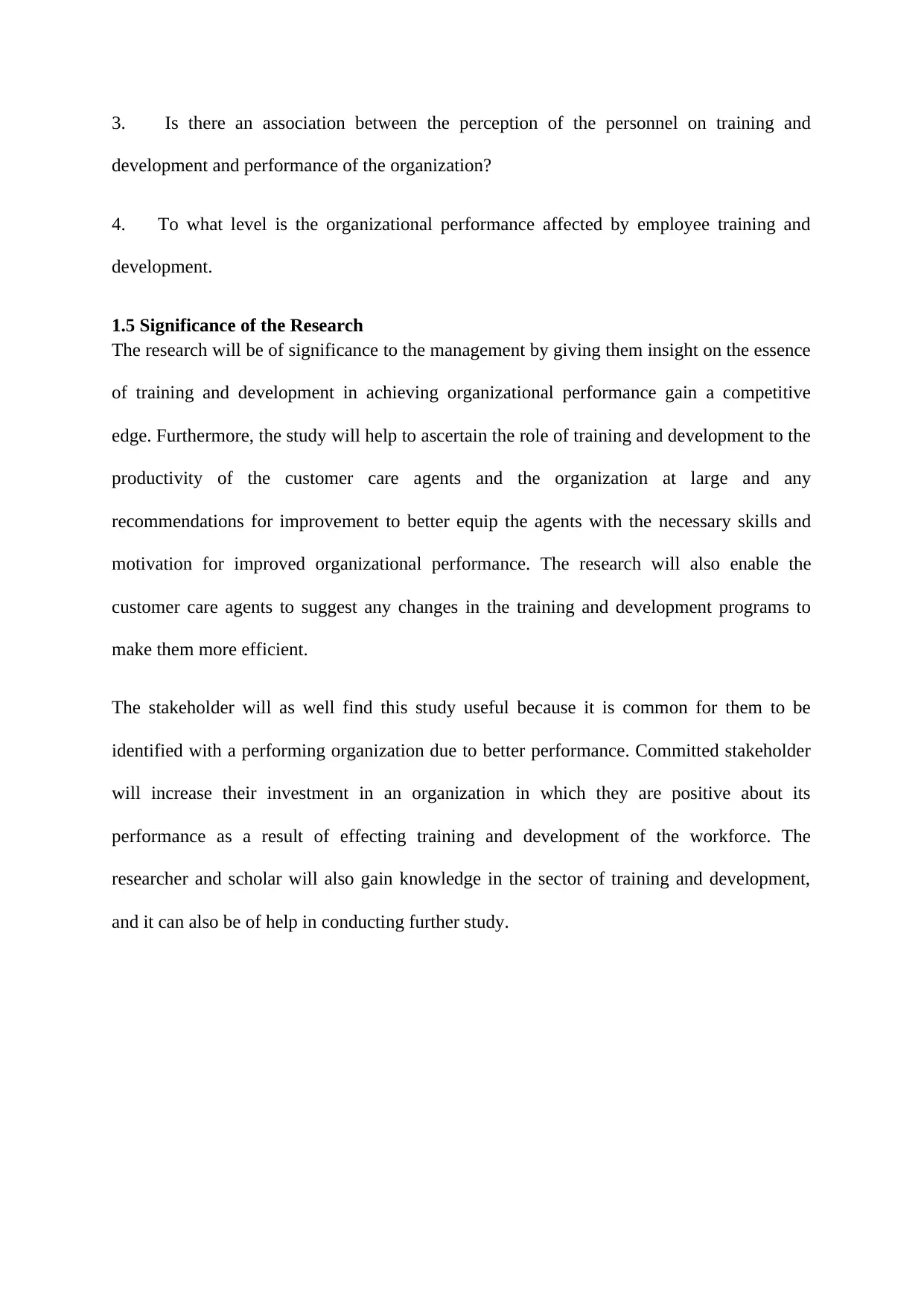
3. Is there an association between the perception of the personnel on training and
development and performance of the organization?
4. To what level is the organizational performance affected by employee training and
development.
1.5 Significance of the Research
The research will be of significance to the management by giving them insight on the essence
of training and development in achieving organizational performance gain a competitive
edge. Furthermore, the study will help to ascertain the role of training and development to the
productivity of the customer care agents and the organization at large and any
recommendations for improvement to better equip the agents with the necessary skills and
motivation for improved organizational performance. The research will also enable the
customer care agents to suggest any changes in the training and development programs to
make them more efficient.
The stakeholder will as well find this study useful because it is common for them to be
identified with a performing organization due to better performance. Committed stakeholder
will increase their investment in an organization in which they are positive about its
performance as a result of effecting training and development of the workforce. The
researcher and scholar will also gain knowledge in the sector of training and development,
and it can also be of help in conducting further study.
development and performance of the organization?
4. To what level is the organizational performance affected by employee training and
development.
1.5 Significance of the Research
The research will be of significance to the management by giving them insight on the essence
of training and development in achieving organizational performance gain a competitive
edge. Furthermore, the study will help to ascertain the role of training and development to the
productivity of the customer care agents and the organization at large and any
recommendations for improvement to better equip the agents with the necessary skills and
motivation for improved organizational performance. The research will also enable the
customer care agents to suggest any changes in the training and development programs to
make them more efficient.
The stakeholder will as well find this study useful because it is common for them to be
identified with a performing organization due to better performance. Committed stakeholder
will increase their investment in an organization in which they are positive about its
performance as a result of effecting training and development of the workforce. The
researcher and scholar will also gain knowledge in the sector of training and development,
and it can also be of help in conducting further study.
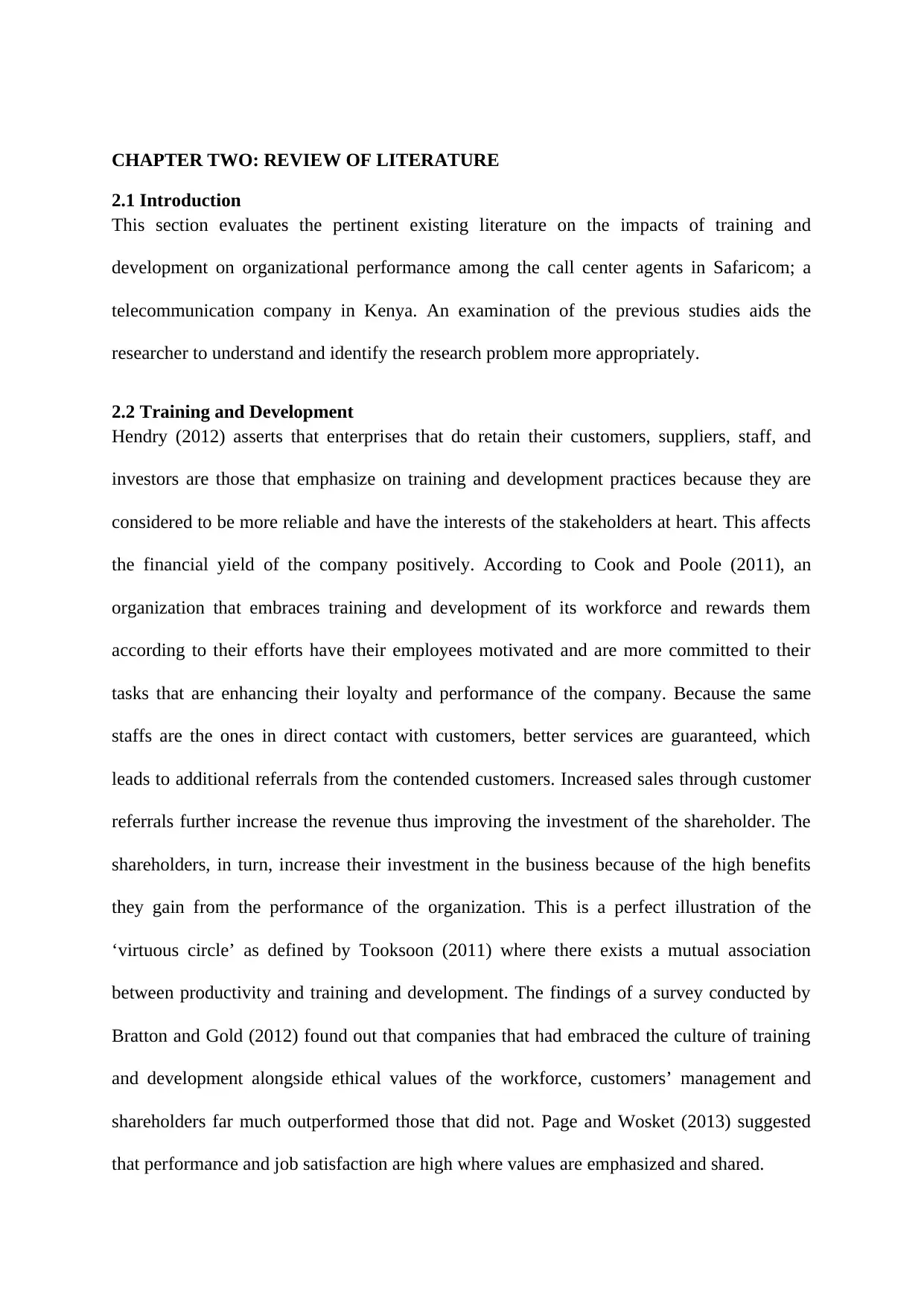
CHAPTER TWO: REVIEW OF LITERATURE
2.1 Introduction
This section evaluates the pertinent existing literature on the impacts of training and
development on organizational performance among the call center agents in Safaricom; a
telecommunication company in Kenya. An examination of the previous studies aids the
researcher to understand and identify the research problem more appropriately.
2.2 Training and Development
Hendry (2012) asserts that enterprises that do retain their customers, suppliers, staff, and
investors are those that emphasize on training and development practices because they are
considered to be more reliable and have the interests of the stakeholders at heart. This affects
the financial yield of the company positively. According to Cook and Poole (2011), an
organization that embraces training and development of its workforce and rewards them
according to their efforts have their employees motivated and are more committed to their
tasks that are enhancing their loyalty and performance of the company. Because the same
staffs are the ones in direct contact with customers, better services are guaranteed, which
leads to additional referrals from the contended customers. Increased sales through customer
referrals further increase the revenue thus improving the investment of the shareholder. The
shareholders, in turn, increase their investment in the business because of the high benefits
they gain from the performance of the organization. This is a perfect illustration of the
‘virtuous circle’ as defined by Tooksoon (2011) where there exists a mutual association
between productivity and training and development. The findings of a survey conducted by
Bratton and Gold (2012) found out that companies that had embraced the culture of training
and development alongside ethical values of the workforce, customers’ management and
shareholders far much outperformed those that did not. Page and Wosket (2013) suggested
that performance and job satisfaction are high where values are emphasized and shared.
2.1 Introduction
This section evaluates the pertinent existing literature on the impacts of training and
development on organizational performance among the call center agents in Safaricom; a
telecommunication company in Kenya. An examination of the previous studies aids the
researcher to understand and identify the research problem more appropriately.
2.2 Training and Development
Hendry (2012) asserts that enterprises that do retain their customers, suppliers, staff, and
investors are those that emphasize on training and development practices because they are
considered to be more reliable and have the interests of the stakeholders at heart. This affects
the financial yield of the company positively. According to Cook and Poole (2011), an
organization that embraces training and development of its workforce and rewards them
according to their efforts have their employees motivated and are more committed to their
tasks that are enhancing their loyalty and performance of the company. Because the same
staffs are the ones in direct contact with customers, better services are guaranteed, which
leads to additional referrals from the contended customers. Increased sales through customer
referrals further increase the revenue thus improving the investment of the shareholder. The
shareholders, in turn, increase their investment in the business because of the high benefits
they gain from the performance of the organization. This is a perfect illustration of the
‘virtuous circle’ as defined by Tooksoon (2011) where there exists a mutual association
between productivity and training and development. The findings of a survey conducted by
Bratton and Gold (2012) found out that companies that had embraced the culture of training
and development alongside ethical values of the workforce, customers’ management and
shareholders far much outperformed those that did not. Page and Wosket (2013) suggested
that performance and job satisfaction are high where values are emphasized and shared.
⊘ This is a preview!⊘
Do you want full access?
Subscribe today to unlock all pages.

Trusted by 1+ million students worldwide
1 out of 44
Related Documents
Your All-in-One AI-Powered Toolkit for Academic Success.
+13062052269
info@desklib.com
Available 24*7 on WhatsApp / Email
![[object Object]](/_next/static/media/star-bottom.7253800d.svg)
Unlock your academic potential
Copyright © 2020–2025 A2Z Services. All Rights Reserved. Developed and managed by ZUCOL.




